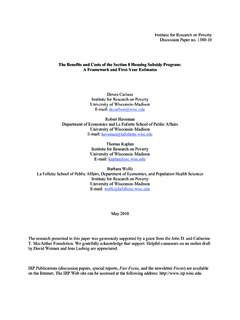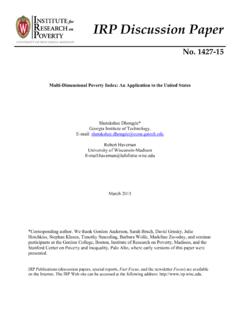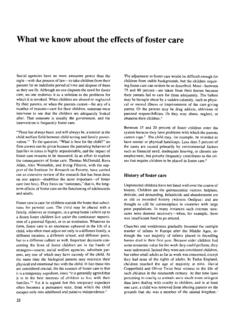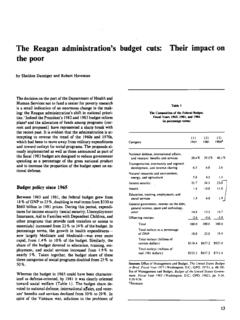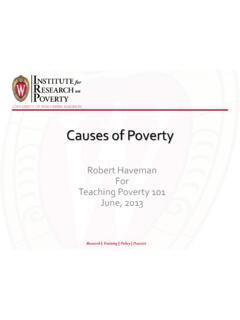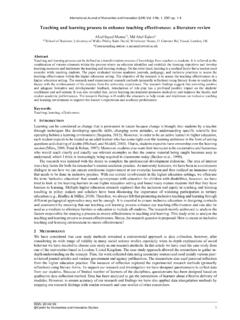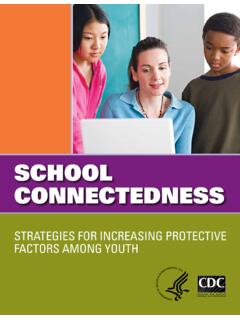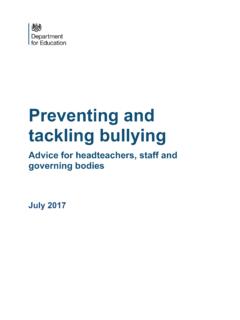Transcription of Improving educational outcomes for poor children
1 56 Improving educational outcomes for poor children2. High-poverty schools lack the capacity to substantially improve student learning, independent of financial re-sources. Potential solutions to this problem would in-volve helping schools improve the quality of their stan-dard operating practices, or increasing the instructional capacity of staff in these schools through professional development or more selective hiring. 3. High-poverty schools do not have sufficient incentives or flexibility to improve instruction. Proponents of this perspective argue that without clarifying key objectives and holding key actors accountable, additional spending will be squandered. 4. Schools matter only so much. The real problem rests with the social context in which schools operate namely, the family, neighborhood, and peer environ-ments that under this perspective make it difficult for low-income children to take advantage of educational opportunities.
2 Adopting accountability or market-oriented reforms without changing social policy more broadly will punish educators for factors beyond their control, and potentially drive the most able teachers toward schools serving less-disadvantaged some reason, current education policy debates often seem to be argued as if the problems listed above are mutually exclusive. In contrast, we believe that there is likely some truth to each of these major explanations; schools confront no single problem that can be addressed with just one solu-tion. Identifying the optimal policy response to the mix of problems that plagues our public schools is complicated by the possibility that these problems might interact with each other. For example, it may be the case that certain curriculum reforms are effective only if they are accompanied by an increase in resources such as student support services, or by an increase in teacher quality generated by reforms to hiring and tenure policies.
3 Social science theory and common sense are likely to carry us only so far in identifying the most effec-tive and cost-effective mix of education policy changes. For almost every education intervention that some theory suggests might be effective, another plausible theory suggests that the intervention is likely to be ineffective or even harm-ful. Education policy also needs to be guided by rigorous evaluation evidence about what actually works in over the past four decades has unfortunately fos-tered the impression that nothing works to improve schools for poor children . One of the first studies to contribute to this sense of pessimism was the landmark 1966 report by soci-ologist James Coleman and his Drawing on a large, nationally representative sample, the Coleman Report found that most of the variation in student test scores occurs within rather than across schools, that family background is the strongest predictor of academic achievement, and that most measurable school inputs like student-teacher ratios are only weakly correlated with student outcomes .
4 Subsequent evaluation studies of different educational interventions also Brian A. Jacob and Jens LudwigBrian Jacob is Walter H. Annenberg Professor of Educa-tion Policy, Professor of Economics, and Director of the Center on Local, State, and Urban Policy at the University of Michigan, as well as Research Associate of the National Bureau of Economic Research. Jens Ludwig is McCormick Foundation Professor of Social Service Administration, Law, and Public Policy at the University of Chicago, Non-resident Senior Fellow in Economic Studies at the Brook-ings Institution, and Research Associate at the National Bureau of Economic of the best ways to avoid being poor as an adult is to obtain a good People who have higher levels of academic achievement and more years of schooling earn more than those with lower levels of human capital. This is not sur-prising, since economists believe that schooling makes people more productive and that wages are related to in modern America, poor children face an elevated risk for a variety of adverse educational outcomes .
5 According to the 2007 National Assessment of educational Progress, only 16 percent of fourth-grade students eligible for free lunch score at proficient levels in reading, compared with 44 percent of fourth graders whose family incomes are above the eligibility cutoff for free The disparity in math scores between those above and below the eligibility thresh-old for free lunch is even Equally large disparities in achievement test scores are observed between whites and minority racial or ethnic groups, with test score gaps that show up as early as three or four years of In fact, the black-white test score gap among twelfth graders may not be all that different in magnitude from the gap observed among young children when they first start why children s outcomes vary so dramati-cally along race and class lines in America is central to for-mulating effective education policy interventions.
6 Disagree-ments about how to improve schooling outcomes for poor children stem in part from different beliefs about the prob-lems that underlie the unsatisfactory outcomes in many of our nation s public schools. Broadly speaking, critics tend to invoke, at least implicitly, one of the following explanations for why children in high-poverty schools are not performing as well as we would like: 1. Schools serving poor and minority students have fewer resources than they need. In this case, a potential solu-tion would be to provide more money to disadvantaged Vol. 26, No. 2, Fall 200957tended to be disappointing, and helped contribute to a sense of pessimism about the ability of schools to improve poor children s life contrast, we offer a message of tempered optimism. Over the past few decades, the technology of education-policy evaluation has improved dramatically, making it much easier to detect moderately-sized program impacts within the com-plex environment that determines schooling outcomes .
7 The available evidence reveals a number of potentially promis-ing ways to improve the learning outcomes of low-income children . This is not to say that everything works: many current and proposed education policies either have no em-pirical support for their effectiveness, or in some cases have strong empirical evidence for their ineffectiveness. The most successful educational interventions will reduce, but not eliminate, racial and social class disparities in educational outcomes . This is not a reason for either despair or inaction. The appropriate standard of success for policy interventions is that they generate net benefits, not miraculous benefits. Education policies that are capable of Improving poor chil-dren s schooling outcomes by enough to justify the costs of these policies are worth doing, even if these policies or programs by themselves are not enough to equalize learning opportunities for all children in resourcesThe question of whether money matters has been the subject of contentious debate in the research literature for the past 40 years.
8 Isolating the causal effects of extra school funding is complicated by the possibility that compensatory spending may be directed towards schools serving the most disadvantaged students, and adequately controlling for all aspects of student disadvantage is quite difficult in practice. The weight of current evidence provides fairly weak support for the idea that increases in unrestricted school funding on average improve student There is, however, stronger evidence that some targeted increases in specific school inputs can improve student outcomes . Three areas in which we believe increased resources may yield important benefits for poor children are (1) increased investments in early childhood education; (2) class-size reductions in the early grades; and (3) targeted salary bonuses to help disad-vantaged schools recruit and retain better Early childhood educationDisparities in academic achievement by race and class are apparent as early as ages three and four well before chil-dren enter kindergarten.
9 Recent research in neuroscience, developmental psychology, economics, and other fields suggests that the earliest years of life may be a particu-larly promising time to intervene in the lives of low-income Studies show that early childhood educational programs can generate learning gains in the short-run and, in some cases, improve the long-run life chances of poor chil-dren. Moreover, the benefits generated by these programs are large enough to justify their preschool interventions represent a promising way to improve the life chances of poor children , their success is not well reflected in federal government budget priorities, which allocate nearly seven times as much money per capita for K 12 schooling as for pre-kindergarten, other forms of early education, and child care subsidies for three- to Most social policies attempt to make up for the disadvantages poor children experience early in life.
10 But given the substantial disparities between poor and nonpoor children that already exist among very young children , it is perhaps not surprising that many disadvantaged children never catch up. Class-size reductionReducing average class sizes may enable teachers to spend more time working with individual students, tailor instruc-tion to match children s needs, and make it easier for teach-ers to monitor classroom behavior. Class-size reductions are expensive, as they require hiring additional teachers and in some cases expanding a school s physical space. However, the best available evidence suggests that class-size reduc-tion, holding teacher quality constant, can improve student outcomes by enough to justify these additional expenditures, with benefits that are particularly pronounced for low-income and minority children . Some research has suggested that class-size reduction might be most effective if focused on low-income districts or Bonuses for teaching in high-needs schools or subjects Research has identified substantial variation across teachers in the ability to raise student achievement, both within and across schools.

